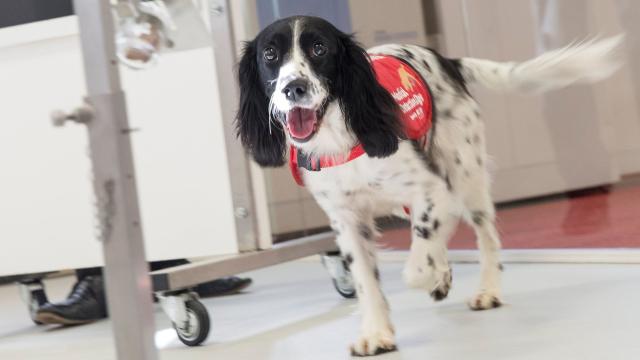New research shows that dogs can be trained to detect the malaria parasite in infected individuals using their keen sense of smell.
In 2016, an estimated 445,000 global deaths were attributed to malaria, according to the World Health Organisation. The number barely budged from the year before, when 446,000 people succumbed to the malaria parasite, Plasmodium falciparum, which spreads through infected female Anopheles mosquitoes.
Overall, global infection rates are even less encouraging; in 2016, an estimated 216 million malaria cases were documented — an increase of five million from the year before.
“Worryingly, our progress on the control of malaria has stalled in recent years, so we desperately need innovative new tools to help in the fight against malaria,” said James Logan, Head of the Department of Disease Control at the London School of Hygiene and Tropical Medicine (LSHTM), in a statement.
Indeed, diagnosing people with suspected infections is a laborious and time-consuming process. New approaches would go a long way to addressing the detection problem, and by consequence, reducing the rate of malaria transmissions.
To that end, Logan, with help from his colleagues at Durham University, sought to learn if sniffer dogs could be used to diagnose malaria in people who don’t exhibit any symptoms.
The idea is not as outrageous as it may seem. Detection dogs are already being used to sniff out some cancers and detect low blood sugar levels in diabetic owners.
Results of this preliminary investigation, the details of which were disclosed at the annual meeting of the American Society of Tropical Medicine and Hygiene in New Orleans, suggests dogs can, in fact, sniff out the disease in infected individuals. This means dogs could represent a rapid and non-invasive tool for detecting for malaria.
In the future, malaria detection dogs could be used at airports, for example, where canines are already being used to sniff out narcotics and illegal foodstuffs. By flagging suspected travellers, these sniffer dogs could prevent malaria from spreading between countries and help infected people get earlier treatment.
For the study, scientists from the LSHTM and the Medical Research Council Unit-Gambia (MRCG) gathered foot odour samples from children aged five to 14 in the Upper River Region of the Gambia in West Africa. Using a standard finger-prick test, the researchers were able to determine which of these children had the malaria parasite Plasmodium falciparum in their blood.
Their socks were then sent to the Medical Detection Dogs (MDD) charity in Milton Keynes, United Kingdom, where dogs have been trained to distinguish the socks worn by infected and uninfected individuals.
Of the 175 samples tested, the dogs were able to correctly identify 70 per cent of malaria-infected samples, while 90 per cent were able to detect socks worn by uninfected individuals. The results aren’t perfect — but they’re far from chance. In a real-world setting, detection dogs could flag individuals for further screening, allowing health officials to perform standardised diagnostic tests.
While promising, this screening strategy is not without its challenges. It may require close contact between a dog and an individual, which might be scary for some people. Alternately, articles of clothing would have to be removed and sniffed by the dogs, which is also not ideal.
At the very least, this latest research provides an important proof-of-principle showing that dogs might be useful for sniffing out malaria in some settings.
“The possible potential to train dogs to detect tropical disease where diagnostics are poor… is huge,” said study co-author Claire Guest, the CEO of Medical Detection Dogs, in a statement.
“I believe that this study indicates that dogs have an excellent ability to detect malaria and if presented within an individual infected with the parasite or a piece of recently worn clothing, their accuracy levels will be extremely high. This is a reliable, non-invasive test and is extremely exciting for the future.”
This is undoubtedly a neat idea, but the real value of this research could be in the way it inspires technological solutions. If a dog’s nose can sniff out malaria, then it’s conceivable that a portable diagnostic device modelled off the canine olfactory system can be developed.
But that’s easier said than done: Dogs have 300 million receptors in their nose, compared to about six million in humans. It’s going to take some time for our technology to catch up with evolution.
